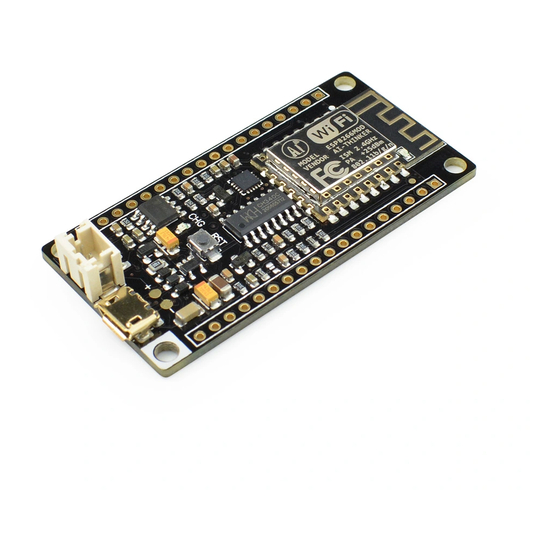
Advertisement
FireBeetle ESP8266 IOT Microcontroller SKU: DFR0489
Introduction
DFRobot FireBeetle is a series of low-power-consumption development hardware designed for
Internet of Things (IoT). Firebeetle ESP8266 is a development board integrated with IoT WiFi,
TCP/IP, 32-bit MCU, 10-bit ADC and multiple interfaces such as HSPI, UART, PWM, I2C and I2S. In
DTIM10, the full power consumption to maintain WiFi connection reached to 1.2mW. Equipped with
16MB outer SPI flash memory, ESP8266 is available for programs and firmware storage.
Compatible with Arduino programming enables Firebeetle ESP8266 to lower the barrier of
programming. Operator can implement Arduino programming codes directly onto ESP8266 to
reduce the difficulty of operating and increase the stability of board.
NOTE: There still remains some bugs to be detected and fixed by developers. In some cases
some peripherals may not work perfectly by embedding Arduino sample codes in ESP8266.
Much more functions implemented in Arduino are still under development and improvement.
An alternative way is to change development tool such as RTOS and MicroPython towards a
more operating-friendly experience in some conditions.
Advertisement
Table of Contents

Summary of Contents for DFRobot FireBeetle ESP8266
- Page 1 DFRobot FireBeetle is a series of low-power-consumption development hardware designed for Internet of Things (IoT). Firebeetle ESP8266 is a development board integrated with IoT WiFi, TCP/IP, 32-bit MCU, 10-bit ADC and multiple interfaces such as HSPI, UART, PWM, I2C and I2S. In DTIM10, the full power consumption to maintain WiFi connection reached to 1.2mW.
- Page 2 Specification Operating Voltage: 3.3V Input Voltage (limits): 3.3~5V (Lithium Battery:3.7V & USB:5V) Microcontroller: Tensilica L106 (32-bit MCU) Clock Speed: 80MHz (Maximum: 160MHz) SRAM:50KB External Flash Memory: 16MB DC Current in the Low-Power-Consumption: 46uA ...
- Page 3 Tutorial In this tutorial, we'll show you some basic operation with FireBeetle-ESP8266 Microcontroller. Requirements Hardware FireBeetle ESP8266 IOT Microcontroller x 1 Micro USB Cable x1 Software Arduino IDE (newest), Click to Download Arduino IDE from Arduino® Download CH340 FireBeetle ESP8266 Window Driver Note: CH340 driver is free to install for most of Windows OS, if you find there is no COM Port in Device Manager, please download the driver and install it.
- Page 4 File->Preferences paste url here...
- Page 5 Click OK Open Tools->Board->Boards Manager, waiting automatic update. You'll find FireBeetle-ESP8266 Now, the development environment has been installed, you can use it like a normal Arduino board.
- Page 6 IO2, which maps D5 in Arduino IDE It is totally different mean with 2 and D2 ! Sample Code ‐ Scan WiFi After you have installed the FireBeetle ESP8266 development environment, it will comes with a lot of sample code in Arduino IDE, you can find them in File > Examples. The follow sample code scans the around WiFi: This sketch demonstrates how to scan WiFi networks.
- Page 7 void setup() { Serial.begin(115200); // Set WiFi to station mode and disconnect from an AP if it was previously connected WiFi.mode(WIFI_STA); WiFi.disconnect(); delay(100); Serial.println("Setup done"); void loop() { Serial.println("scan start"); // WiFi.scanNetworks will return the number of networks found int n = WiFi.scanNetworks(); Serial.println("scan done");...
- Page 8 Serial.println(""); // Wait a bit before scanning again delay(5000); Open your Arduino IDE serial monitor: For any questions, advice or cool ideas to share, please visit the DFRobot Forum. https://www.dfrobot.com/product‐1634.html 11‐2‐17 ...




Need help?
Do you have a question about the FireBeetle ESP8266 and is the answer not in the manual?
Questions and answers